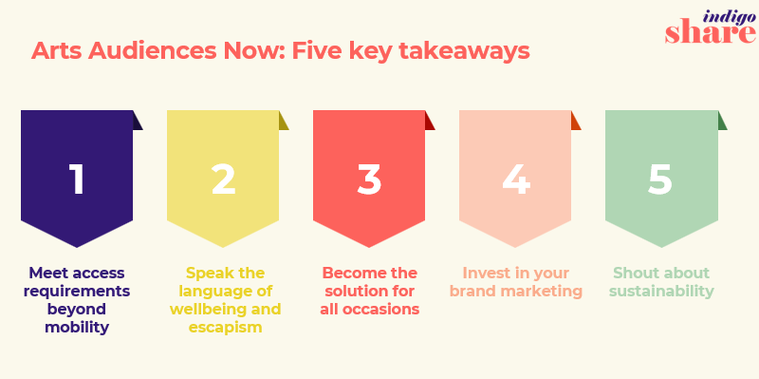
On Tuesday 20 May 2025, we shared the collective results which form our UK-wide benchmark for 2024/25 in a free webinar (to be added here soon).
Here, Katy Raines reflects on what this data tells us about how to connect better with arts audience now.
1. Meet access requirements beyond mobility
As we saw in our recent Hot Topic, Access Culture, access requirements are no longer just about checking you have level access or hearing loops, although these are obviously expected requirements. One in ten audiences say they have an access requirement and there’s a gap between needs and satisfaction ratings, so we need to think more broadly.
What do a new and younger generation of audiences need? They might need to know when your foyer is busy or visual stories to prep for a visit. Younger people are more likely to give up on their booking if they can't get information online about access, so test your website with people who have different requirements – and make improvements. If we can welcome the widest range of needs, everyone benefits.
2. Speak the language of wellbeing and escapism
This year’s results show once again that wellbeing and escapism are some of the biggest personal impacts of engaging with arts and culture. In a time where funding is frankly terrifying and the whole sector feels uncertain, let’s lean into these broader benefits for audiences. Let’s remind them that we’re here to make them feel great, to give them the mindful moments they are seeking in a busy and stressful world. And then let’s tell stakeholders, funders and donors: share the results from your own Indigo Share Subscription surveys or the sector benchmark; do a bit of googling and craft your own compelling narrative of why the arts is the best medicine, and how you’re delivering on that to your local residents.
3. Become the solution for all occasions
Younger and new audiences are particularly likely to attend for a special occasion. We see this consistently every year and explored it at length in our Hot Topic, Tomorrow’s Audience. But I feel we sometimes get our thinking on this wrong. We don’t have to wait until a show, film or exhibition that feels like a “special occasion” one. We need to make ourselves the solution for any occasion – get ourselves there, top of mind, to current and potential audiences.
Make sure you have and promote a special occasion package on any show. Talk frequently on social and in paid campaigns about how special it is to spend time at your place – perhaps you could promote it as a “different” or quirky way to celebrate a special moment. Show people having a great time in your imagery. Make sure if they think of a special celebration, that you’re in the mix.
4. Invest in your brand marketing
People want to spend time in places where they feel welcome, they feel at home and they identify with the values and, quite frankly, the vibe. If you’re on the hamster wheel of show by show promotion, jump off and invest some time and some money in talking about who you are, what you stand for, what benefits you offer audiences.
Make it really clear what audiences will get out of a visit to you. Try and tell the story that arcs across everything you programme, not just the story of that visit. Make sure you build on your relationships with audiences after they’ve been – not just to sell on the next show you want them to come to, but to talk to ask them about their experience, tell them what you’ve changed after their feedback, offer them ways to dive further into the thing they came to see, tell them about the impact they have had on a young person’s life thanks to that top up donation…anything to help build their sense of connection to you.
5. Shout about sustainability
We have to get more confident and vocal on this issue. This metric is persistently low: only half our respondents think organisations are showing a commitment to sustainability.
There’s loads that can help you in our three years of Act Green research. We have also picked up some top tips from our Indigo Share subscribers this year who are doing it well. Fundraising campaigns around sustainability initiatives can really help cut through. Where sustainability and climate crisis issues are built into programming, ratings are much higher.
If you can’t do either of these, then why not talk about what your audiences are doing to help you be greener, like the decrease in petrol car usage in this year’s benchmark? Or talk about the things you feel really confident in – local food sourcing in your café, recycling set materials, reducing energy usage. From what audiences tell us, we need to worry less about being accused of green washing or about someone challenging us and be more confident to shout about what we are doing, own what we’re not yet doing and get this conversation front and centre with audiences.